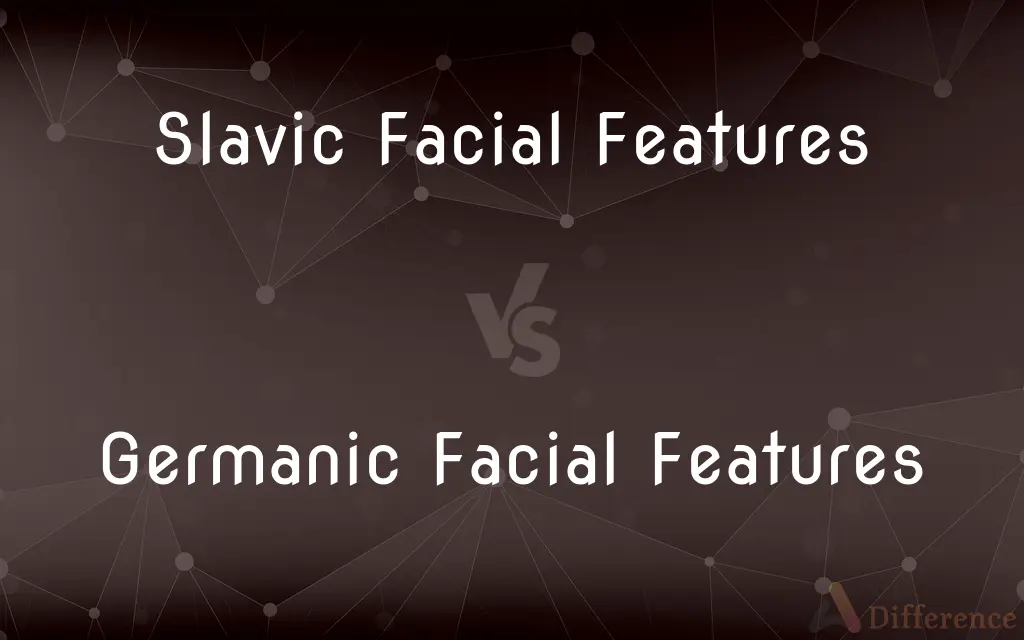Slavic Facial Features vs. Germanic Facial Features — What's the Difference?
By Tayyaba Rehman & Maham Liaqat — Published on November 5, 2024
Slavic facial features often include high cheekbones and round faces, while Germanic features tend to have strong jawlines and narrower faces.

Difference Between Slavic Facial Features and Germanic Facial Features
Table of Contents
ADVERTISEMENT
Key Differences
Slavic facial characteristics are diverse, reflecting the vast geographic spread and ethnic diversity of Slavic peoples. Common traits include high cheekbones, rounder faces, and sometimes a prominent brow ridge. These features are thought to be adaptations to the colder climates of Eastern Europe. On the other hand, Germanic facial features, attributed to peoples originating from Northern and Central Europe, often showcase strong jawlines, narrower faces, and a broader forehead, which are characteristics that have been historically noted in various Germanic populations.
Slavic eyes are typically almond-shaped with a wide range of colors, whereas Germanic eyes are often lighter in color, including blue, green, or gray, with a shape that can range from almond to round. The variation in eye shape and color between these groups can be significant, illustrating the genetic diversity within each population.
The nose shape among Slavic individuals tends to be broad and straight, adapting to colder climates, whereas Germanic noses are often narrower and more aquiline. This difference in nasal structure may reflect historical adaptations to different environmental conditions, with broader noses better suited to humidify and warm cold air.
Skin tones between the two groups can also vary, with Slavic individuals often having lighter skin that can tan to a moderate olive shade in the sun. In contrast, Germanic individuals typically have lighter skin that may burn more easily. This variation in skin response to sunlight exposure again reflects the diverse evolutionary backgrounds and geographical distributions of these populations.
Hair texture and color range widely among both Slavic and Germanic peoples, with Slavic hair ranging from straight to wavy, and colors from dark to light. Germanic hair tends to be straighter and can range from blond to dark, reflecting the wide genetic diversity within these groups.
ADVERTISEMENT
Comparison Chart
Face Shape
Rounder faces, high cheekbones
Narrower faces, strong jawlines
Eye Shape
Almond-shaped, wide color range
Varies from almond to round, lighter colors
Nose Shape
Broad and straight
Narrower and more aquiline
Skin Tone
Light, can tan to moderate olive
Light, may burn easily
Hair Texture/Color
Ranges from straight to wavy, dark to light
Tends to be straighter, blond to dark
Compare with Definitions
Slavic Facial Features
Round faces are common among Slavic peoples.
His round face was a characteristic Slavic trait.
Germanic Facial Features
Narrower faces are typical in Germanic genetics.
Her narrow face reflected her Germanic ancestry.
Slavic Facial Features
Slavic skin can tan to a moderate olive shade.
Despite her light skin, she tanned to an olive shade, a Slavic feature.
Germanic Facial Features
Germanic noses tend to be narrower and more aquiline.
The aquiline shape of her nose was a Germanic trait.
Slavic Facial Features
Slavic features often include high cheekbones.
Her high cheekbones hinted at her Slavic heritage.
Germanic Facial Features
Lighter eye colors are common among Germanic peoples.
His blue eyes were a characteristic Germanic feature.
Slavic Facial Features
Broad, straight noses are notable in Slavic faces.
The broad shape of his nose was indicative of Slavic ancestry.
Germanic Facial Features
Germanic skin may burn easily in the sun.
His skin burned easily, a common Germanic characteristic.
Slavic Facial Features
Slavic eyes can vary widely in color.
Her almond-shaped, green eyes were typical of Slavic genetics.
Germanic Facial Features
Germanic features often showcase strong jawlines.
His strong jawline was a sign of his Germanic roots.
Common Curiosities
What are Germanic facial features?
Germanic features typically include strong jawlines, narrower faces, lighter eye colors, narrower aquiline noses, and skin that may burn easily.
Can someone have a mix of Slavic and Germanic features?
Yes, due to historical migrations and mixing, individuals can have a combination of traits from both groups.
What are Slavic facial features?
Slavic features include high cheekbones, round faces, almond-shaped eyes, broad noses, and a skin tone that can tan to an olive shade.
Are there exceptions to these typical features?
Yes, there's significant diversity within each group, and not everyone will fit these generalizations.
How do environmental factors influence facial features?
Facial features can be adaptations to climate, such as broader noses in colder climates to humidify air, or skin tone variations for UV radiation protection.
Is it possible to determine ancestry based on facial features alone?
While facial features can provide clues, they are not definitive proof of ancestry due to the wide variation within populations.
Can cultural practices influence facial features?
Over generations, environmental and lifestyle factors might influence certain physical traits, but genetic factors primarily determine facial features.
Why is there such variety in hair texture and color?
Genetic diversity and mutations over time contribute to the wide range of hair textures and colors within and across populations.
Do facial features change over time?
Yes, facial features can evolve over generations due to environmental adaptations and genetic mixing.
What is the significance of jawline differences?
Jawline differences are mostly aesthetic and can influence perceptions of attractiveness rather than having functional significance.
Do these features affect health in any way?
Some features, like skin tone, can influence vitamin D synthesis and sunburn risk, but most facial features do not directly affect health.
How do Slavic and Germanic features compare in eye color?
Slavic eyes can be any color, often almond-shaped, whereas Germanic eyes tend to be lighter in color.
How do scientists study the genetics of facial features?
Through genetic research and studying population genetics, scientists can trace the origins and migrations of different peoples.
Are there any stereotypes associated with these facial features?
While stereotypes exist, it's important to approach them critically and recognize the diversity within any population.
How do modern movements of people affect the distribution of these features?
Global mobility leads to more genetic mixing, potentially blending or changing these typical features over time.
Share Your Discovery

Previous Comparison
Akinesia vs. Akathisia
Next Comparison
Fire Truck vs. Fire EngineAuthor Spotlight
Written by
Tayyaba RehmanTayyaba Rehman is a distinguished writer, currently serving as a primary contributor to askdifference.com. As a researcher in semantics and etymology, Tayyaba's passion for the complexity of languages and their distinctions has found a perfect home on the platform. Tayyaba delves into the intricacies of language, distinguishing between commonly confused words and phrases, thereby providing clarity for readers worldwide.
Co-written by
Maham Liaqat













































